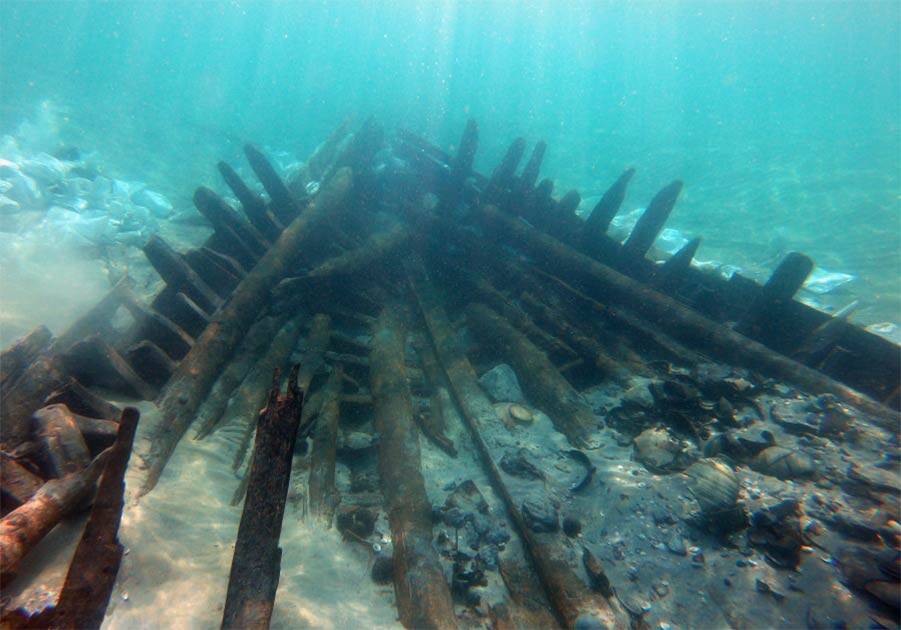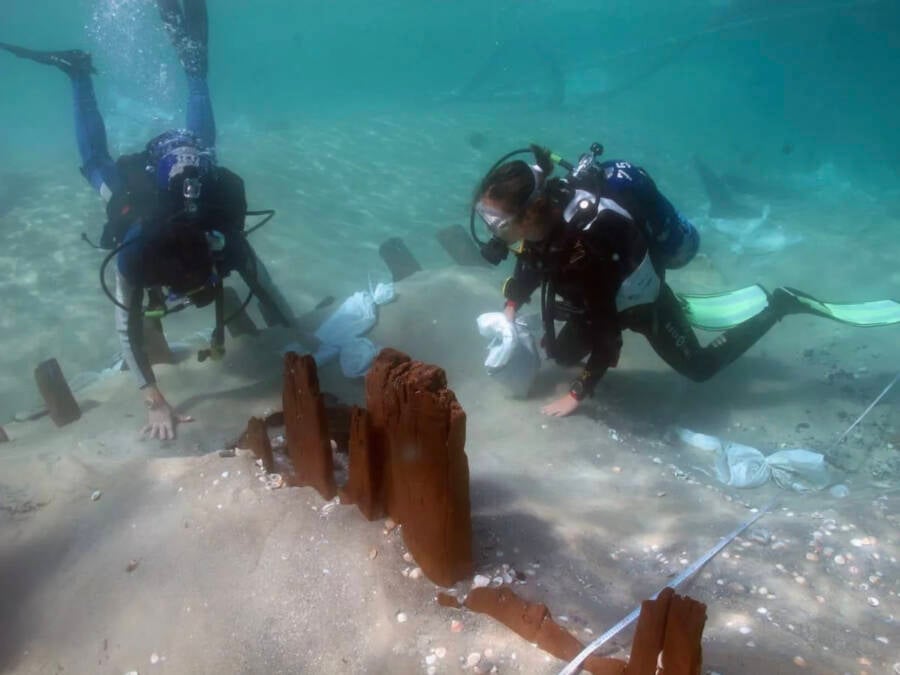The seventh-century ship held the largest collection of Byzantine and early Islamic pottery ever found in Israel.

University of Haifa, Institute for Maritime StudiesThe ship’s method of construction differed greatly from popular approaches of prior centuries, giving experts insight into the transitional period between Byzantine and Islamic rule.
In 2015, two members of an Israeli kibbutz near Haifa spotted some intriguing wreckage off the coast. The ship was rapidly retaken by sand until the University of Haifa managed to launch excavations in 2016.
Not only was the ship 1,300 years old, but it had both Christian and Muslim inscriptions within.
According to The Jerusalem Post, the university’s Institute for Maritime Studies has gained invaluable insight into the region’s cultural life at the time. The 85-foot ship yielded 103 Greco-Roman jars (or amphorae) filled with agricultural products and well-preserved Greek and Arabic writing.
Published in the Near Eastern Archaeology journal, the findings detail how much has been learned about the transition between Byzantine and Islamic rule, ship construction, and the standardized ship routes of the time.
The chance discovery by Kibbutz Ma’agan Michael members has made this find all the more remarkable, as this is officially the largest maritime cargo collection of Byzantine and early Islamic pottery ever found in Israel.

University of Haifa, Institute for Maritime Studies
Since the vessel seemed to have wrecked fewer than 100 feet from the coast, it’s unlikely that anyone aboard died during the accident. Fortunately for modern-day researchers, the sea and sand have preserved the ship and its contents rather well, ever since.
“We have not been able to determine with certainty what caused the ship to wreck, but we think it was probably a navigational mistake,” said study author and university archaeologist Deborah Cvikel. “We are talking about an unusually large vessel, which was carefully built and is beautifully conserved.”
What the experts do seem fairly certain about is the ship’s trade route. Cvikel said that it “was definitely traveling around the Levant,” with stops in Cyprus, Egypt, and potentially another port on Israel’s coast — before succumbing to the ocean.
Perhaps most fascinating is that the find might force historians to reassess presumptions that the transition between Byzantine and Islamic rule between seventh and eighth centuries severely impeded commerce in the Eastern Mediterranean.
The sizable and varied cargo found aboard — and the diverse cultural and religious iconography found within — increasingly challenge that notion.

University of Haifa, Institute for Maritime StudiesThe amphorae, or Greco-Roman jars, contained agricultural products from figs and pine nuts to grapes, raisins, and olives.
“We do not know whether the crew was Christian or Muslim, but we found traces of both religions,” said Cvikel.
The uncovered inscriptions were written in both Greek and Arabic, with Muslim and Christian religious symbols such as the name of Allah and numerous Christian crosses discovered aboard. These finds were either carved into the wood of the ship itself or found on the amphorae it was carrying.
The latter contained fruits such as olives, dates, figs, grapes, raisins, and pine nuts. Of the six types of amphorae, there were two typologies that have never been found before. Fishbones were found inside, with a lack of human remains aboard reinforcing the idea that the accident took no lives.
“We have not found any human bone, but we assume that because the ship sank so close to the coast, nobody died in the wreckage,” said Cvikel.
The ship’s construction, meanwhile, appeared to be Egyptian. Cvikel explained these vessels were built using a “shell-first” method, which was based on strakes — essentially, a line of planking from the stem to the stern in order to give the ship its structural integrity and shape.
This differed greatly from the “skeleton-first” construction popular during the fifth and sixth centuries, in which the strakes were fastened to the reconstructed frames, instead.

University of Haifa, Institute for Maritime StudiesIt’s been generally believed that the transition between Byzantine and Islamic rule across seventh and eighth centuries limited Eastern Mediterranean commerce. The ship’s cargo challenges that notion.
“This process of ‘transition in ship construction’ has been one of the main topics in the history of shipbuilding for about 70 years, and some issues have remained unanswered,” said Cvikel.
“Therefore, each shipwreck of this period holds a vast amount of information that can shed further light on the process.”
Unfortunately, the global COVID-19 pandemic has put a temporary halt on the ongoing excavation of the site. The university’s Institute of Maritime Studies and its ambitious team of doctoral and master’s students have had to put the project on hold. Fortunately, they’re all well aware of what’s left to be done.
“We still need to uncover the rear part of the ship, where presumably the captain lived,” said Cvikel. “We also need to carry out more analysis on many of the findings, including the amphorae, their content, the everyday objects, such as the cookware, and the animal bones.”
While this mandatory research break is surely quite frustrating for experts and onlookers alike, there’s no doubt their analysis will eventually resume. In the grand scheme of history — and this ship’s 1,300-year-long slumber in the sea — what’s another few months, really?
After reading about the 1,300-year-old shipwreck with Islamic and Christian inscriptions found off Israel’s coast, learn about 10 sunken ships from around the world and their astonishing shipwreck sites. Then, take a look at 27 shocking images of the Israel-Gaza conflict.




